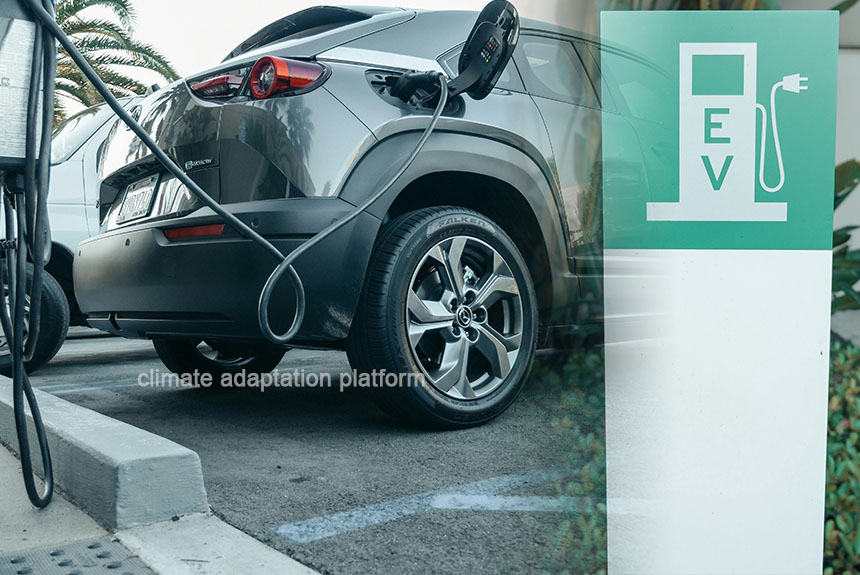Electric vehicles are touted as a solution to reduce carbon emissions and fight climate change. Switching to EVs has key benefits, including lowering GHG emissions.
In 2022, cars accounted for almost half (48%) of global transport CO2 emissions. This makes their share four times higher than that of international shipping and even air travel, at 11%. Switching to EVs can help lower transportation’s share of global emissions.
Falling costs of electric vehicles have increased global sales, accounting for a 10% share of passenger vehicles sold in 2022, according to data from the IEA. However, according to a high-ambition scenario from Climate Action Tracker, the sales figure needs to grow 75% to 95% by 2030 to limit warming consistent with the Paris Agreement of 1.5°C.
Successful EV adopters
The article from WRI lists the top five countries with the fastest rate of EV uptakes.
Norway is at the top, with 80% of its all-electric passenger vehicle sales in 2022. Iceland follows at 41%, Sweden at 32%, the Netherlands at 24%, and China at 22%.
Analysis of the International Energy Agency data shows that once countries reach a 1% share of EV sales, they grow much faster than countries that adopted EVs earlier.
“For example, India’s EV sales grew from 0.4% to 1.5% in just one year from 2021 to 2022. That’s about three times faster than the global average, which took three years to grow from 0.4% EV sales in 2015 to 1.6% in 2018. Israel jumped from 0.6% EV sales to 8.2% in just two years, from 2020 to 2022. It took over five years to achieve that much growth, from 0.5% in 2016 to 6.2% in 2021.”
Large car markets can drive global sales
The article notes that the three biggest car markets—China, Europe, and the United States, which account for 60% of global car sales—can help the world transition to electric vehicles. In the US, passing the Inflation Reduction Act provided a generous tax break of up to $7,500 for those who want to purchase an EV. Since then, it has driven more than $62 billion in investment from carmakers and suppliers, according to Bank of America Research.
How have Norway and China achieved EV success?
The article looks at the factors behind the high sales of EVs in these two countries.
In Norway, its government’s deliberate actions through incentives and tax breaks have made it easier and cheaper for Norwegians to buy and maintain EVs than traditional ICE vehicles. Their government also heavily invests in EV charges, making the country have the world’s most public fast charges per capita. EV owners also enjoy free parking, exemptions in road tolls, and access to bus lanes.
China’s high sales volume helped drive down battery costs. In 2022, 22% of its passenger vehicle sales were electric cars. China was behind other countries in producing traditional ICE vehicles, so it saw an opportunity to invest early in EVs. The government started rolling out financial subsidies and tax breaks for EV manufacturers and consumers as early as 2009 and 2010 and pilot cities nationwide. Two decades later, every 8 out of 10 EVs sold in China are made by Chinese companies and have begun to export globally.
The article notes that government policies and incentives are powerful drivers for EV adoption in countries with high adoption rates, and other countries should follow their examples.
Mandating 100% of EV sales is also effective in driving the transition in some countries. Still, in terms of driving down EV costs, policy alignment of large EV manufacturers like China, the EU, and the US in the short term or by 2035 could scale up production and lower costs worldwide.
Transitioning to EVs is just a part of the story. To truly decarbonize the transportation sector, carbon-spewing vehicles such as the old gas and diesel-powered cars will need to be retired, and the transport system needs to be transformed by offering alternative forms of mobility.
Source:
Distribution of carbon dioxide emissions produced by the transportation sector worldwide in 2022, by sub-sector. (2023, September 22). Statista. Retrieved from https://www.statista.com/statistics/1185535/transport-carbon-dioxide-emissions-breakdown/
Jaeger, J. (2023, September 14). These Countries Are Adopting Electric Vehicles the Fastest. World Resource Institute. Retrieved from https://www.wri.org/insights/countries-adopting-electric-vehicles-fastest
Inflation Reduction Act 2022: Sec. 13401 Clean Vehicle Credit. (2023 May 25). IEA. Retrieved from https://www.iea.org/policies/16277-inflation-reduction-act-2022-sec-13401-clean-vehicle-credit
Fujita, A. (2023, August 16). Inflation Reduction Act: How the climate law set a ‘trillion-dollar shift’ for EVs into motion. Yahoo Finance. Retrieved from https://finance.yahoo.com/news/inflation-reduction-act-how-the-climate-law-set-a-trillion-dollar-shift-for-evs-into-motion-155615359.html



Leave a Reply